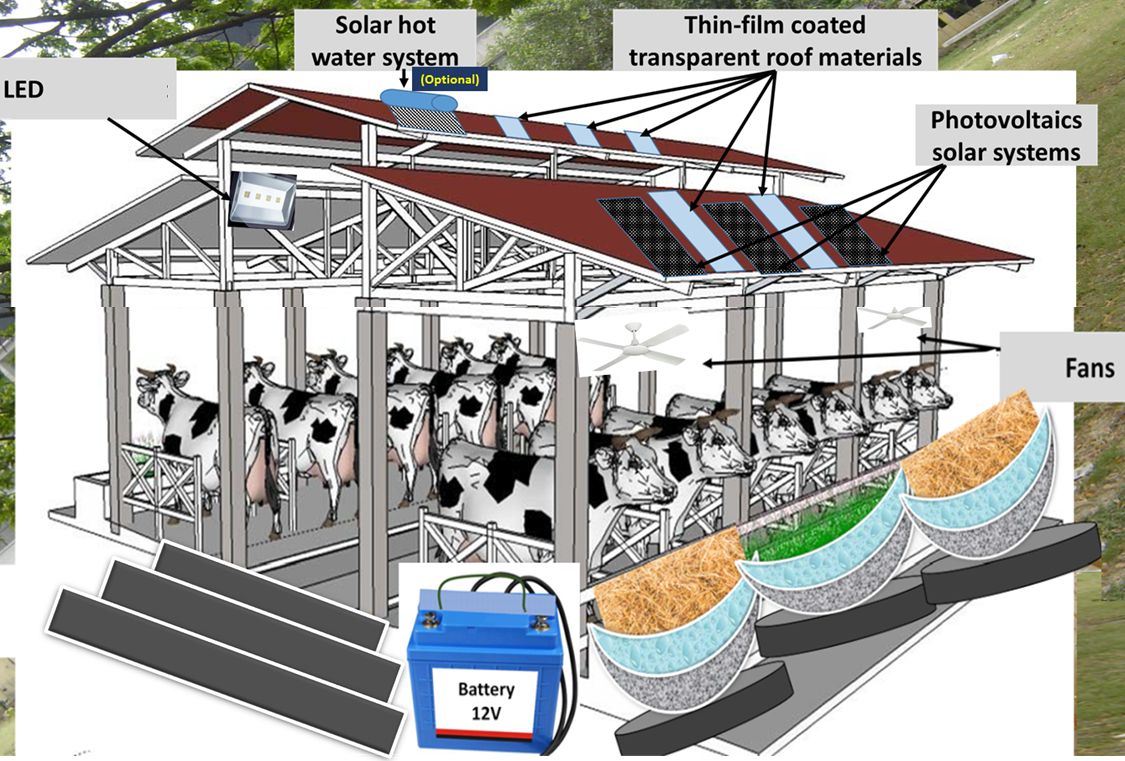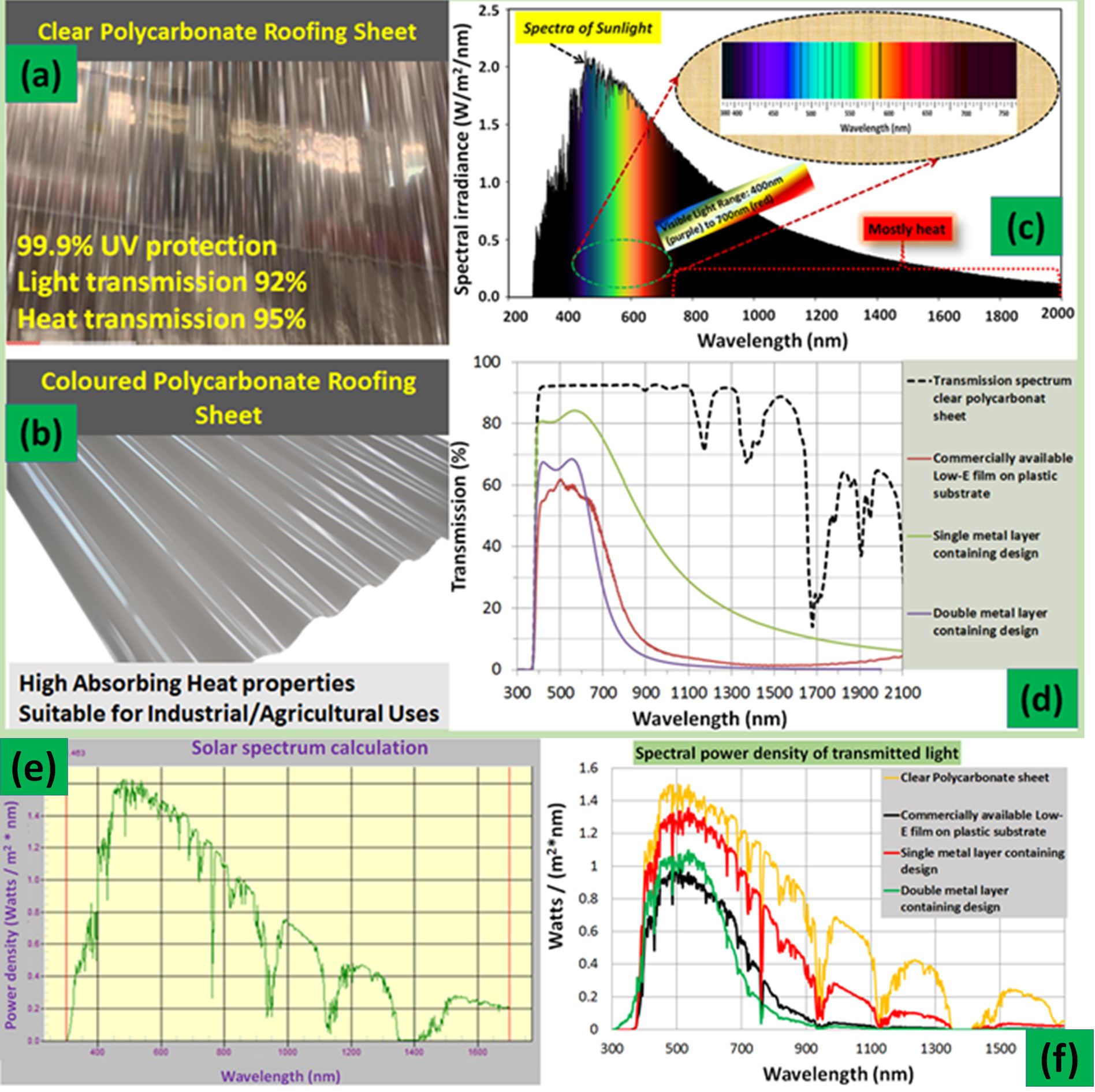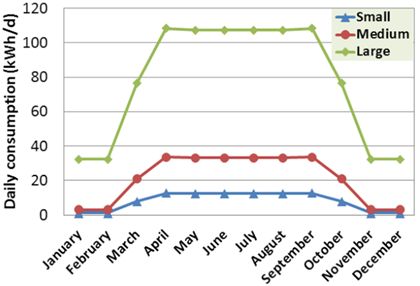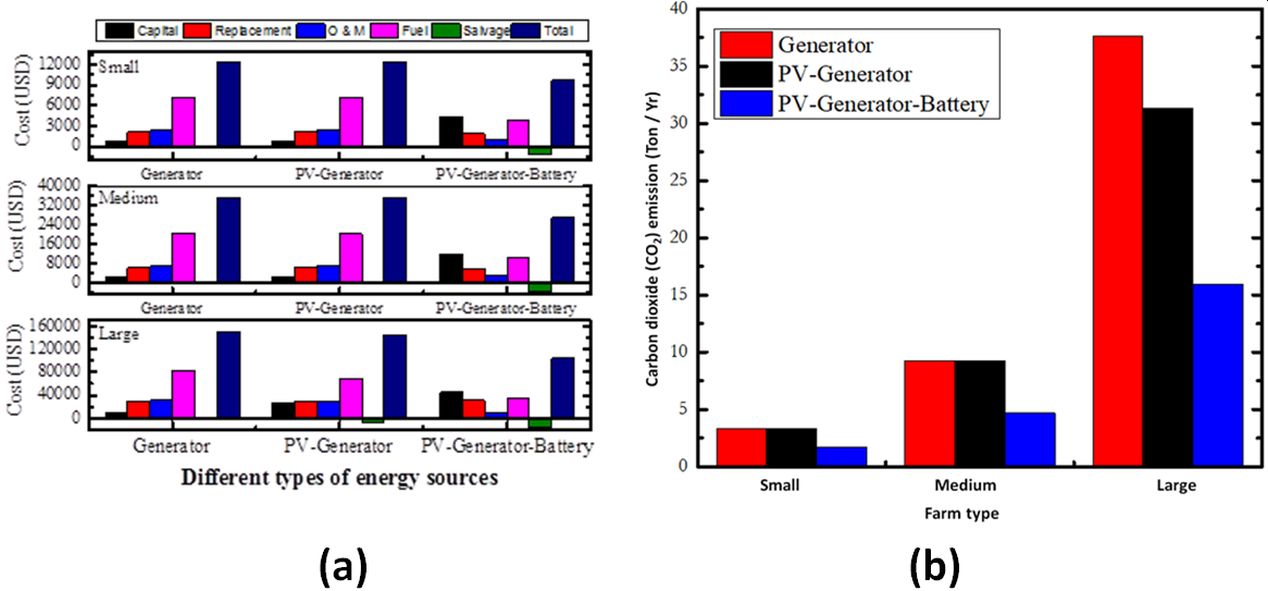We like to report on the concept of an advanced energy-engineering system for self-sustainable and rural areas farming and cultivation (RAFC). In this energy-engineering approach, we accounted for the effects of thin-film coated energy-saving features, in an optimized off-grid hybrid power generation system for advanced farm-house. Design and optimization of a hybrid (photovoltaic-battery-generator) power system have been performed by using the Hybrid Optimization of Multiple Energy Resources (HOMER Pro _ Version 3.14.0) software, developed by National Renewable Energy Limited (NREL, Boulder, CO 80301, USA). Optimized results show that the off-grid hybrid system together with the additional Low-E type coating assisted energy-saving features is more feasible for next-generation modern cultivation and farming with long-term sustainability.
- Cattle farming
- COVID-19 pandemic
- food safety
- HOMER
- hybrid system
- smallholder
- thin-film coating.
1. Introduction
In modern day’s agriculture including cultivation and farming, energy security (continuous, and uninterrupted power supply) has become of prime importance for maintaining a continuous production cycle for the world population food-supply-chain demand. Recent advances in renewable energy technology, especially in the solar photovoltaics (PV), and others, help to ensure the availability of energy for rural and remote areas. However, dependence on only one renewable energy generation system is not quite a reliable option to ensure a continuous supply of power for many rural areas. Therefore, hybrid power generation systems (where more than one renewable energy source are combined) have recently become more favorable to confirm the power-supply for those places like islands or coastal areas where the grid connection is always not possible or there is no alternative to micro-grid systems. However, the question is, “Can only power generation be an appropriate solution to achieve green and sustainable global energy demand?” We believe that as renewable energy generation is not the ultimate of having a fossil fuel-less world to reduce the carbon dioxide footprint. The energy savings and energy consumption in an efficient way can pave the way for achieving sustainable earth for all living beings.
In modern day’s agriculture including cultivation and farming, energy security (continuous, and uninterrupted power supply) has become of prime importance for maintaining a continuous production cycle for the world population food-supply-chain demand. Recent advances in renewable energy technology, especially in the solar photovoltaics (PV), and others, help to ensure the availability of energy for rural and remote areas. However, dependence on only one renewable energy generation system is not quite a reliable option to ensure a continuous supply of power for many rural areas. Therefore, hybrid power generation systems (where more than one renewable energy source are combined) have recently become more favorable to confirm the power-supply for those places like islands or coastal areas where the grid connection is always not possible or there is no alternative to micro-grid systems. However, the question is, “Can only power generation be an appropriate solution to achieve green and sustainable global energy demand?” We believe that as renewable energy generation is not the ultimate of having a fossil fuel-less world to reduce the carbon dioxide footprint. The energy savings and energy consumption in an efficient way can pave the way for achieving sustainable earth for all living beings.
Nur-E-Alam, et. al., has recently reported on the design and optimization of a hybrid power system together with thin-film Low-E coating assisted power-saving features to enable to simultaneously generate and save energy, suitable for next-generation cultivation and farming systems in rural and remote areas in BangladeshNur-E-Alam, et. al., has recently reported on the design and optimization of a hybrid power system together with thin-film Low-E coating assisted power-saving features to enable to simultaneously generate and save energy, suitable for next-generation cultivation and farming systems in rural and remote areas in Bangladesh[1]. Bangladesh is a small country on the world map; located in south Asia having a land area of 1,47,570 square kilometers, but it has a large population which is over 160 million. Besides industrialization and other commercial infrastructures agriculture plays an important role in the country’s economy. Agriculture and livestock not only lift the Gross Domestic Product (GDP), they also ensure food security and help to reduce poverty and unemployment in rural areas. The authors of the reference article[1], have conducted the energy management and feasibility study of a new approach of an energy-engineering concept that can have a significant impact on rebuilding the country's economy in post-COVID-19 Bangladesh. They have demonstrated based on the simulation optimization of a hybrid energy system by following their new energy-engineering approach (EEA) that it is possible to design cost-effective, environment-friendly small and medium-size farms where the energy payback period can only be around 3.5 to 5 years. The details of optimization design, process, and obtained results together with the possibility of spectrally designed optical thin-film coatings are elaborately discussed in the published Ref.[1]. To demonstrate the advanced energy-engineering concept, the authors proposed a cattle house that contains a hybrid power generation system, in conjunction with energy-saving thin-film coated roof materials as schematized in Figure 1.

Thin-film coating mainly the low-emissivity (low-E) coating assisted roof material can filter daytime sun irradiation as the most of the low-E coatings are designed to filter the visible spectrum whilst reflecting the infrared (IR) spectrum.

Overall features and performance of thin-film coatings (Figure 2d-f) undoubtedly indicate that thin-film coated transparent or semitransparent construction materials (roof or side-wall) can be an additive to save energy for any type of infrastructures for sustainable green earth. For the economic feasibility study of energy engineering aspects, three types of cattle farms (small, medium, and large), were considered during the simulation process using HOMER. The table below presents the criteria and detailed information for different types of the farm used in this study.Overall features and performance of thin-film coatings (Figure 2d-f) undoubtedly indicate that thin-film coated transparent or semitransparent construction materials (roof or side-wall) can be an additive to save energy for any type of infrastructures for sustainable green earth. For the economic feasibility study of energy engineering aspects, three types of cattle farms (small, medium, and large), were considered during the simulation process using HOMER. The table below presents the criteria and detailed information for different types of the farm used in this study.
Table 1. Criteria of different types of cattle farms (in terms of the number of cows).
|
Particular |
Unit |
Herd size |
||
|
Small |
Medium |
Large |
||
|
Area of the farm |
Acre |
0.5 to 2.0 |
2.1 to 5.0 |
Above 5.0 |
|
Headcount of milking cows |
Number |
5 to 20 |
21 to 50 |
Above 50 |
|
Headcount of milking cows for this study |
Number |
13 |
35 |
100 |
|
Shed area |
Row shape |
Single row |
Double row |
Separate shed |
2
This study helps to configure a sustainable power source which has been designed by considering PV cells, storage device, diesel generator, converter, and other appropriate devices. The economic analysis was performed using the HOMER software for different types of farms considering the load consumption the most important part of any power system. The load consumption profile indicates the variation of load demand at a different time of the day, month, and season. ADetail calculation of load consum
This study helps to configure a sustainable power source which has been designed by considering PV cells, storage device, diesel generator, converter, and other appropriate devices. The economic analysis was performed using the HOMER software for different types of farms considering the load consumption the most important part of any power system. The load consumption profile indicates the variation of load demand at a different time of the day, month, and season. Detail calculation of load consumption can be found in the reference article
ption can be found in the reference article
[1]
. Figure 3 shows the monthly load profile for different types of farms.

Figure 3. Monthly load profile for different types of farms.
Figure 4 is reproduced from the original source published in Ref
[1]
. It can be seen that the capital cost increases for a three power source component contained (PV, generator, and battery) hybrid system compared to the single component (i.e., generator only) power system and a double power source component (i.e., PV and generator) hybrid system. However, the total cost is low for a three power source component contained (PV, generator, and battery) hybrid system due to low fuel consumption. It indicates that fuel cost is drastically reduced for PV, generator, and battery hybrid system. Besides this operation and maintenance cost is also low for this system due to reduced operating hours of the generator.

3. Conclusion
Based on the simulation results, we have concluded five important remarks about this study:
Based on the simulation results, we have concluded five important remarks about this study:1. In this study, the Levelized cost of energy (LCOE) for small, medium, and large-size farms is 0.451, 0.467, and 0.508 USD/kWh respectively. It can be concluded here that medium and small size farms are more feasible than the large farms in rural areas for off-grid power supply systems.
1. In this study, the Levelized cost of energy (LCOE) for small, medium, and large-size farms is 0.451, 0.467, and 0.508 USD/kWh respectively. It can be concluded here that medium and small size farms are more feasible than the large farms in rural areas for off-grid power supply systems.2. The total cost for PV, generator, and battery hybrid system is lower than the generator only or PV and battery system. On the other hand PV, generator, and battery hybrid systems significantly reduce the greenhouse gas emission. Therefore, the PV, generator, and battery hybrid systems are economically and environmentally feasible for off-grid power generation in rural areas of Bangladesh.
2. The total cost for PV, generator, and battery hybrid system is lower than the generator only or PV and battery system. On the other hand PV, generator, and battery hybrid systems significantly reduce the greenhouse gas emission. Therefore, the PV, generator, and battery hybrid systems are economically and environmentally feasible for off-grid power generation in rural areas of Bangladesh.3. Cattle farm is more convenient if its size is synchronized with the local market. Because, if it requires time for trading the milk, it needs to be stored in a refrigerator. As a result of the proposed PV, generator and battery hybrid system may not be ideal due to high load demand.
3. Cattle farm is more convenient if its size is synchronized with the local market. Because, if it requires time for trading the milk, it needs to be stored in a refrigerator. As a result of the proposed PV, generator and battery hybrid system may not be ideal due to high load demand.4. Though the capital cost and initial investment are very high for large farm compare with the small or medium type farms, the payback period for small and medium farms are 4.7 and 4.6 years respectively. If the government, makes some subsidy then the payback period will reduce significantly.
4. Though the capital cost and initial investment are very high for large farm compare with the small or medium type farms, the payback period for small and medium farms are 4.7 and 4.6 years respectively. If the government, makes some subsidy then the payback period will reduce significantly.5. According to the current local market, fuel price is $ 0.77 /L which may have a great impact on the LCOE confirmed by several studies which were performed based on the diesel price (0.2-0.5 $/L), the LCOE is found in the range of 0.22-0.35 $/kWh.
5. According to the current local market, fuel price is $ 0.77 /L which may have a great impact on the LCOE confirmed by several studies which were performed based on the diesel price (0.2-0.5 $/L), the LCOE is found in the range of 0.22-0.35 $/kWh.Also, we have found the energy payback period for small and medium farms is 4.7 and 4.6 years, while for a large size farm the energy payback period could be 3.5 years.
Also, we have found the energy payback period for small and medium farms is 4.7 and 4.6 years, while for a large size farm the energy payback period could be 3.5 years.
References
- Nur-E-Alam, M.; Hoque, M.N.; Ahmed, S.M.; Basher, M.K.; Das, N. Energy Engineering Approach for Rural Areas Cattle Farmers in Bangladesh to Reduce COVID-19 Impact on Food-Safety. Preprints 2020, 2020090498 (doi: 10.20944/preprints202009.0498.v1).
